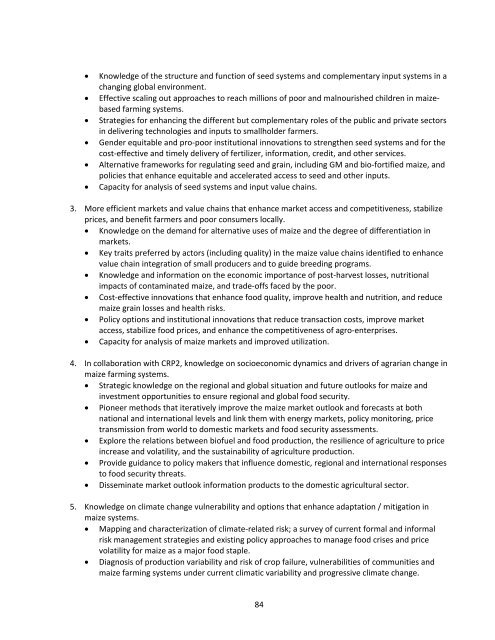Download - Maize
Download - Maize
Download - Maize
Create successful ePaper yourself
Turn your PDF publications into a flip-book with our unique Google optimized e-Paper software.
Knowledge of the structure and function of seed systems and complementary input systems in a<br />
changing global environment.<br />
Effective scaling out approaches to reach millions of poor and malnourished children in maizebased<br />
farming systems.<br />
Strategies for enhancing the different but complementary roles of the public and private sectors<br />
in delivering technologies and inputs to smallholder farmers.<br />
Gender equitable and pro‐poor institutional innovations to strengthen seed systems and for the<br />
cost‐effective and timely delivery of fertilizer, information, credit, and other services.<br />
Alternative frameworks for regulating seed and grain, including GM and bio‐fortified maize, and<br />
policies that enhance equitable and accelerated access to seed and other inputs.<br />
Capacity for analysis of seed systems and input value chains.<br />
3. More efficient markets and value chains that enhance market access and competitiveness, stabilize<br />
prices, and benefit farmers and poor consumers locally.<br />
Knowledge on the demand for alternative uses of maize and the degree of differentiation in<br />
markets.<br />
Key traits preferred by actors (including quality) in the maize value chains identified to enhance<br />
value chain integration of small producers and to guide breeding programs.<br />
Knowledge and information on the economic importance of post‐harvest losses, nutritional<br />
impacts of contaminated maize, and trade‐offs faced by the poor.<br />
Cost‐effective innovations that enhance food quality, improve health and nutrition, and reduce<br />
maize grain losses and health risks.<br />
Policy options and institutional innovations that reduce transaction costs, improve market<br />
access, stabilize food prices, and enhance the competitiveness of agro‐enterprises.<br />
Capacity for analysis of maize markets and improved utilization.<br />
4. In collaboration with CRP2, knowledge on socioeconomic dynamics and drivers of agrarian change in<br />
maize farming systems.<br />
Strategic knowledge on the regional and global situation and future outlooks for maize and<br />
investment opportunities to ensure regional and global food security.<br />
Pioneer methods that iteratively improve the maize market outlook and forecasts at both<br />
national and international levels and link them with energy markets, policy monitoring, price<br />
transmission from world to domestic markets and food security assessments.<br />
Explore the relations between biofuel and food production, the resilience of agriculture to price<br />
increase and volatility, and the sustainability of agriculture production.<br />
Provide guidance to policy makers that influence domestic, regional and international responses<br />
to food security threats.<br />
Disseminate market outlook information products to the domestic agricultural sector.<br />
5. Knowledge on climate change vulnerability and options that enhance adaptation / mitigation in<br />
maize systems.<br />
Mapping and characterization of climate‐related risk; a survey of current formal and informal<br />
risk management strategies and existing policy approaches to manage food crises and price<br />
volatility for maize as a major food staple.<br />
Diagnosis of production variability and risk of crop failure, vulnerabilities of communities and<br />
maize farming systems under current climatic variability and progressive climate change.<br />
84

















